From Habitat magazine - issue 29
How bach design differs from your everyday house.
Nothing else symbolises the relaxed holiday lifestyle quite like the bach. Or crib as they call it in the south, or holiday home if you live beyond our shores.
Whether by the beach, lake or mountain, this modest dwelling is an iconic part of our history and culture, and sums up the meaning of escape from the city and ordinary working life.
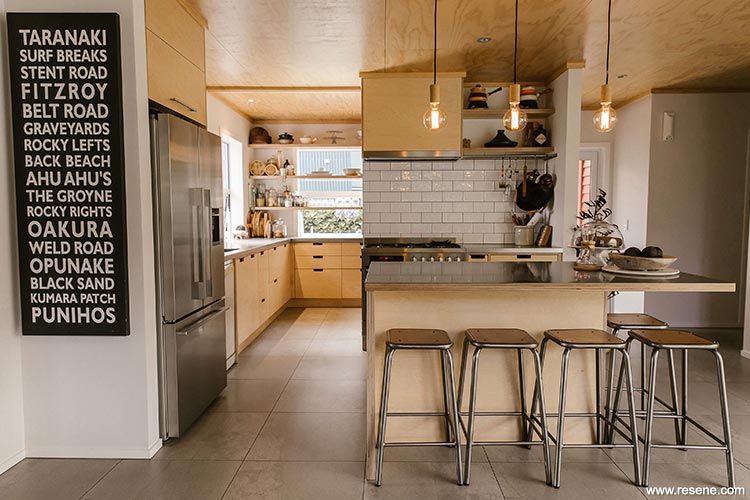
Interior designer Anna Major from Haus of Design created a contemporary interior with a muted palette for this Taranaki bach, using plywood finished in Resene Aquaclear urethane, walls in Resene Sea Fog and a feature wall in Resene Gravel.
Baches became popular in the 1950s when roads improved and cars became more common, giving access to more remote places. They were almost always small and made of cheap and sometimes recycled materials like fibrolite, corrugated iron or used timber. As we’ve become more affluent and building codes stricter, they’ve grown more sophisticated. Yet still, many bach owners want to reflect a simpler, back to-nature way of life that departs from the everyday.
“A bach represents a form of nostalgia harking back to a simpler life. It’s a sanctuary from urban business,” says designer Liz Kerby of Lizzie K & Co. “It’s a touchstone, a soulful place where you can add your own personality and character.”
Wellington architect Gerald Parsonson has no time for those who plonk standard homes from suburbia by the sea for holidays. “It grates. It destroys part of the beauty of the area.”
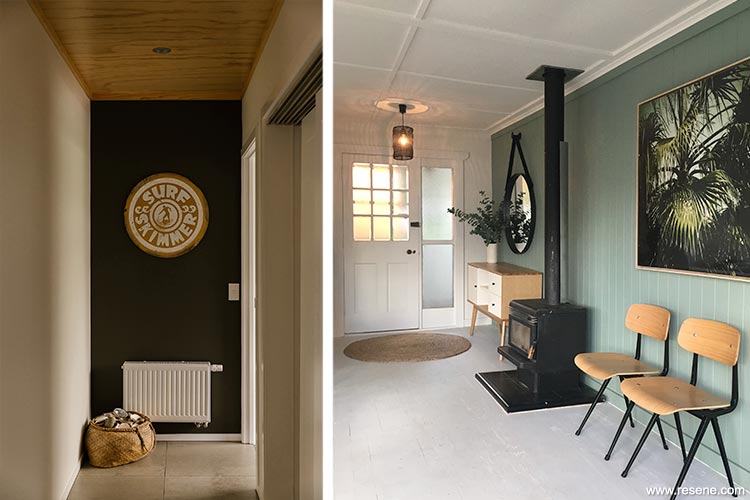
Left: A contemporary interior from Anna Major from Haus of Design. Right: The colours chosen by designer Liz Kerby of Lizzie K & Co for this bach on Auckland’s west coast reflect the bush-clad hills and stormy seas. Resene Bluegrass is used on a tongue-and-groove wall that runs through the entry way and dining space. The floor is painted in Resene Quarter Foggy Grey.
When designing baches, he takes inspiration from the environment. “Every site is different. If it’s a steep site in the Marlborough Sounds, we’re influenced by how it fits on the land. If it’s a flat coastal site, then it’s a different dwelling.
“There’s a playfulness to these holiday homes that comes from the history,” says Gerald. “Having it beachy and basic is a good aspiration. Furnishings can be quite mad. It’s nice to turn up and kick sand through the house and not be hung up about kids and dog activity.”
Layouts are determined as much by relaxed attitudes as modest budgets. Hence the lack of front entries, says Gerald. “Baches can be quite casual in the way bedrooms come off living areas and so on. They have multi-purpose spaces. A bedroom might be behind sliding doors.
“You can use basic materials and colour more playfully. Old baches were typically slapped together with fibro-cement cladding. It was easy to knock them up in plywood, so we’ve tried to use these sorts of materials. They’re really low maintenance and easy to paint,” he says.
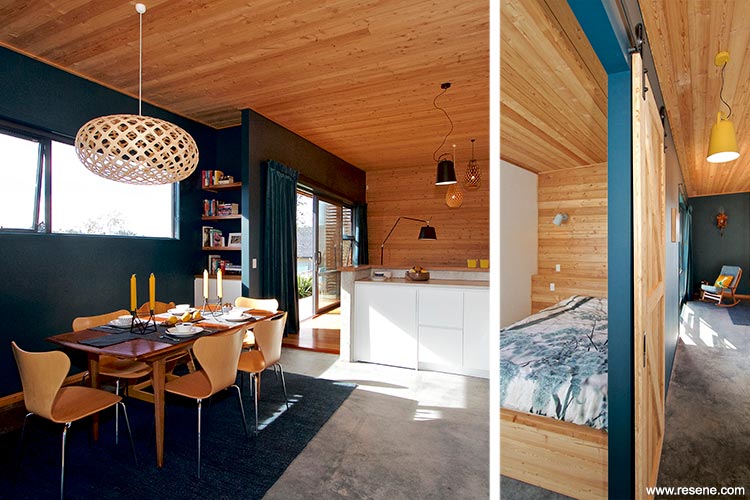
When Maurice Reeger of MnM Design created his own alpine retreat, he used Resene Elephant as a cool counterpoint to timber linings.
Designer Anna Major from Haus of Design in New Plymouth also encourages her clients to be sympathetic to the surroundings. “In Taranaki, we’re inundated with beauty in our mountain and coastal areas.” For remote locations, security is often key, says Anna. When she designed a new bach in Oakum recently, it was about creating the ability to easily lock up and leave, so she specified sensor lights and aluminium joinery.
In regions of high salt exposure, she uses premium Resene Lumbersider on exterior walls and inside, she uses Resene SpaceCote – “you can wash it and it won’t tarnish. It’s a premium washable paint that avoids a lot of fingermarks on the walls.” Anna recommends hard-wearing materials for easy-care. When it comes to furnishings, Anna says: “There’s so much available in op shops for crockery and beachy elements. Also look for country-style furniture that’s been re-upholstered. Focus on quality over quantity.”
“People often like to bring the nostalgic aspect inside,” says Liz Kerby. “Honest natural materials and soft sea tones are relaxing and neutral. It’s an escape from the city so use rustic textures to blend with the scenery.”
Liz’s own bach gave her an opportunity to create a different environment to her modern city home. “We had a more textural look with second-hand finds that immediately created a sense of nostalgia that was comforting. It can be quite different depending on where the bach is located. You might have lots of stone and a schist fireplace in an alpine region or lots of whitewashed timber floors, walls and ceilings or mats on walls in a coastal region.”
And because baches are all about people gathering to socialise, she says, kitchens are smaller. “After all, most cooking happens outside in summer – on barbecues, braziers or fire pits.”
Vanessa Nonsense of Nes Design owns a streamlined minimalist city home and wanted completely the opposite for her Waihi bach. “You can be a bit braver with colour in a bach because you’re not living with it on a daily basis.”
Some of the family surf, so the bach has a relaxed surfie vibe with cane and rattan furniture and denim cushions featuring surfing brands. Edgy art prints represent the sea and surf while bags and caps on display add colourful interest. “When you don’t have a lot of storage, use the vertical wall space to hang things on pegs and shelves,” she suggests.
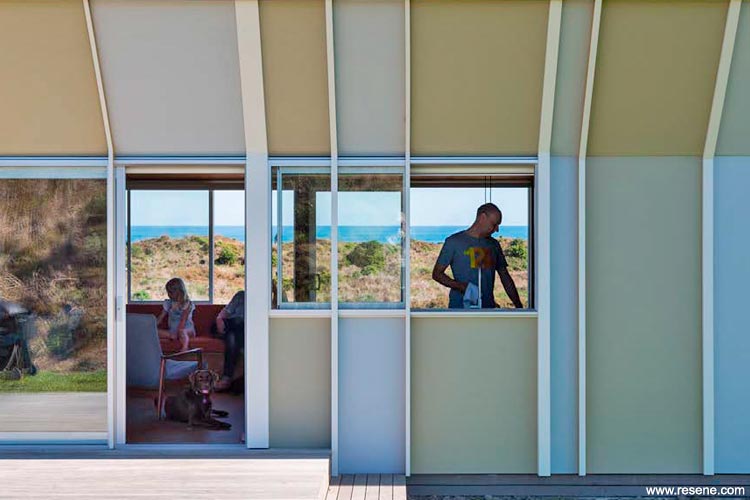
Architect Gerald Parsonson’s clients Richard Stewart and Kerry Sexton wanted their holiday home in Te Horo, north of Wellington, to feel like a bach, not a house that happens to be at the beach. He designed a small 87m2 retreat that was economical to build in fibro-cement and batten cladding with a simple pitched roof angled to catch the nor-wester breeze and shelter from southerlies. This bach won Resene Total Colour Awards for its interior and exterior and for the colours used
Covenants on the subdivision restricted exterior colour options to greys and creams. However, owner Richard says: “The bach theme gave us the option to have a bit of fun and play with multiple colours.” To create a relationship between the bach and the blades of grass growing out of the sand dunes, they painted vertical stripes, using a tonal colour scheme. As you turn around the house, the colours get brighter. Then they brought the colours inside to connect the two. The bedroom features Resene Classius walls and Resene Boulevard. Resene Boulevard is from an older colour collection; try Resene Sorrento as an alternative.
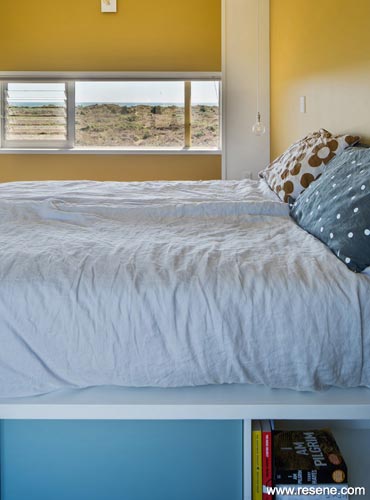
Beachy – use chalky whites like Resene Merino, along with faded blues, like Resene Slipstream and sand colours like Resene Smoothie. Decorate with driftwood, shells, beach ornaments, Cape Cod chairs, ceramic or metallic fish, colourful canvas stripes, log fires and window shutters.
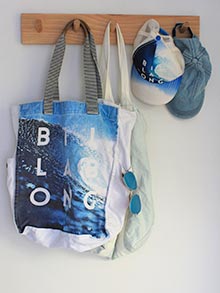
Above: Vanessa Nouwen’s old bach has been
repainted throughout with Resene Black White to make it feel bigger, and accessorised with blues.
Nautical/boathouse – decorate with whitewashed floors and walls, painted oars, marine-inspired tongue and groove walls, colourful canvas stripes, charts and maps, natural rattan shades and weathered surfaces. Try accents of navy and stormy blues like Resene Submerge and Resene Coast.
Surfie – use primary accents alongside surf boards, surf shop art, caps and bags in surf brands, denim cushions and surf break prints. Colours to try are fresh yellows, reds and greens like Resene Chorus Line, Resene Poppy and Resene Away We Go.
Retro – play up the heritage aspect of existing baches. Update existing retro kitchens with colourful cabinetry and funky handles, kitsch art and objects from op shops, second-hand furniture, Crown Lynn pottery and old photos in frames. Retro colours to try include teals, mustards and oranges like Resene She’ll Be Right, Resene Cleopatra and Resene Adrenalin.
Rustic and raw – use plywood, concrete, upcycled timber furniture, chunky tables and rusted metals. Protect timber with a durable urethane like Resene Aquaclear and protect concrete floors with Resene Concrete Wax.




Designers: Liz Kerby, Lizzie K & Co, Anna Major, Haus Design, Gerald Parsonson, www.p-a.nz; Maurice Reeger, www.mnmdesign.co.nz
Words: Vicki Holder
Images: Paul McCredie, Glyn Hubbard, Aimee Kelly
Search habitat magazine stories
Printed copies of habitat highlights are available from late March 2024 at Resene ColorShops and resellers, while stocks last. You can view back issues of habitat magazine online.
Specifiers:
If you have an idea, project or story that you think would suit habitat, we’d love to hear from you. Please drop us an email with your details and include photos if submitting a project.
Sign up for a DIY card and Save! Australia | New Zealand